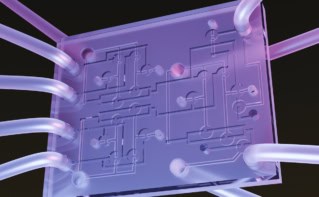
Graphene boasts many exceptional properties, and researchers in the US have found yet another one: a rare electronic state called multiferroicity that could double the amount of information stored in future graphene-based devices. This state, which only appears when five layers of graphene are stacked together, could be exploited to design ultralow power, high-capacity and high-speed data storage systems for classical and quantum computing.
Graphene is a two-dimensional crystal of carbon atoms arranged in a honeycomb pattern, and some of its amazing properties, such as high electrical conductivity and exceptional strength, were recognized even before it was first synthesized in 2004. More recently, scientists have found that stacking graphene in multiple layers causes a range of unusual electronic behaviours to appear, including superconductivity and “flat” electronic bands.
A team at the Massachusetts Institute of Technology (MIT) led by physicist Long Ju has now added to this list of unusual graphene behaviours by showing that the material exhibits a rare multiferroic state when stacked in five layers. More specifically, this five-layer graphene exhibits both unconventional magnetism and an exotic type of electronic behaviour that the researchers have dubbed “ferro-valleytricity”.
Ferroicity and multiferroicity
Ferroic materials are those that exhibit a spontaneous ordering of their electric, magnetic or structural properties. The best-known example of ferroicity is ferromagnetism, in which the magnetic moments of a material all point in one direction, but other types of ferroic ordering are possible. In ferroelectricity, for example, it is the electric polarization that spontaneously orders itself, while ferroelastic materials display spontaneous strain.
Multiferroicity occurs when several properties of a material have their own individual preferred states. For example, a magnetic multiferroic material might have magnetic moments that point in one direction, and electric charge that also shifts in a certain direction. Importantly, the two phenomena are independent of each other.
Such materials are interesting for electronics because they could double the amount of information that can be stored relative to conventional devices while operating much faster. This is because the magnetic domains could be switched by a fast, lower-power electric field, rather than by an electric current (an energy-intensive and relatively slow process) as conventional domains are.
Coordinated behaviour
In the new work, which is detailed in Nature, Ju and colleagues calculated that a type of coordinated behaviour should emerge in a structure made up of five graphene layers stacked atop each other in a rhombohedral pattern. In such a structure, the electrons move very slowly, so they interact with each other more efficiently. Because of this, Ju explains that they start to correlate and coordinate into certain preferred ferroic orders.
Experiments on real five-layer graphene backed up this hypothesis. In these studies, the team measured how electrons in their samples behaved in response to an applied electric- and magnetic field and found that different types of coordinated ferroic behaviours appeared.
The first of these behaviours is an unconventional form of magnetism in which the electrons exhibited coordinated orbital motion. The second involves graphene’s so-called electronic valley. In conductive materials, electrons can occupy certain energy levels, and a valley represents the lowest of these energy states.
Happy valleys
“As it turns out, there are two possible valleys in graphene,” Ju explains. “Normally, electrons have no preference for either valley and settle equally into both. But we found that they begin to coordinate and prefer to settle in one valley over the other. This second coordinated behaviour indicates a ferroic property that, combined with the electrons’ unconventional magnetism, gives the structure a rare, multiferroic state.”

Graphene ribbons advance twistronics
This is the first time ferro-valleytronics has been observed and also the first time it has been seen to accompany unconventional ferromagnetism, he adds.
Both of the ferroic properties can be controlled using an electric field. This means that if the five-layer graphene was incorporated into a memory chip, for example, its electronic properties could be manipulated in two ways rather than one, effectively doubling the data that could be stored in it compared to conventional materials. However, Ju cautions that there is much work to do before this becomes possible.



